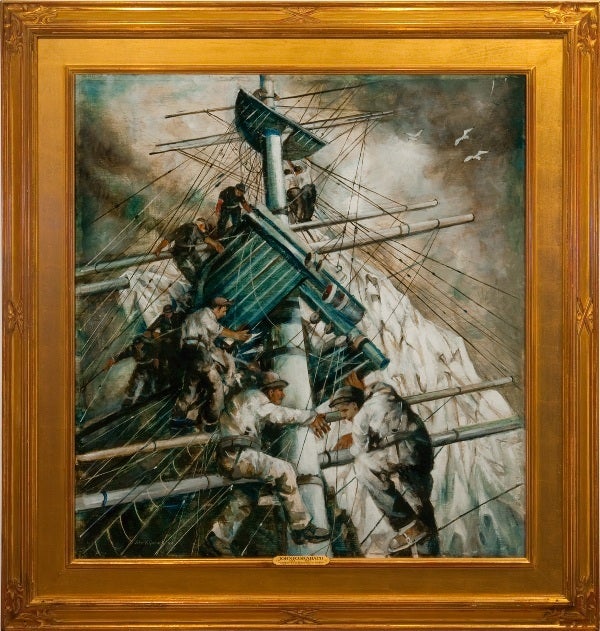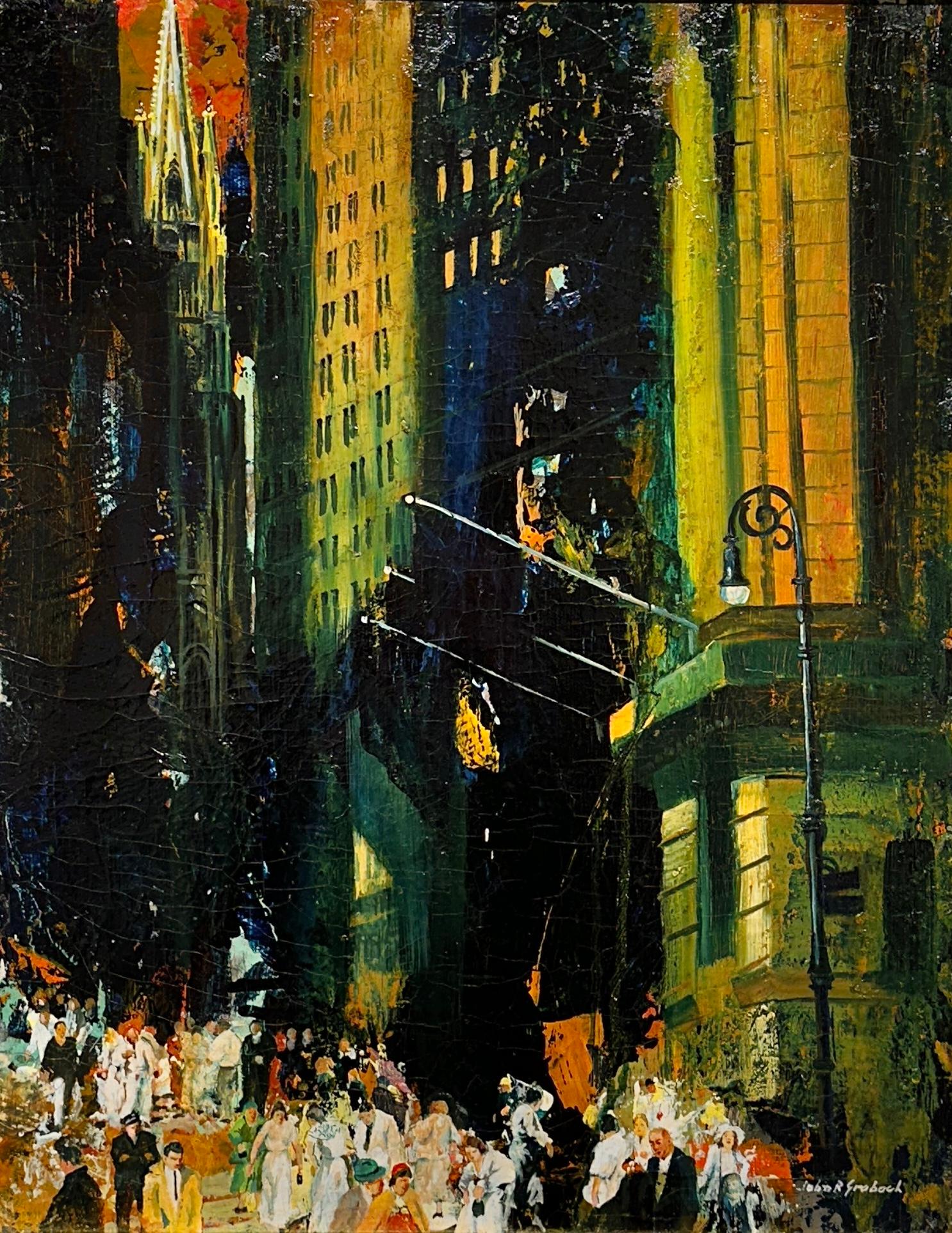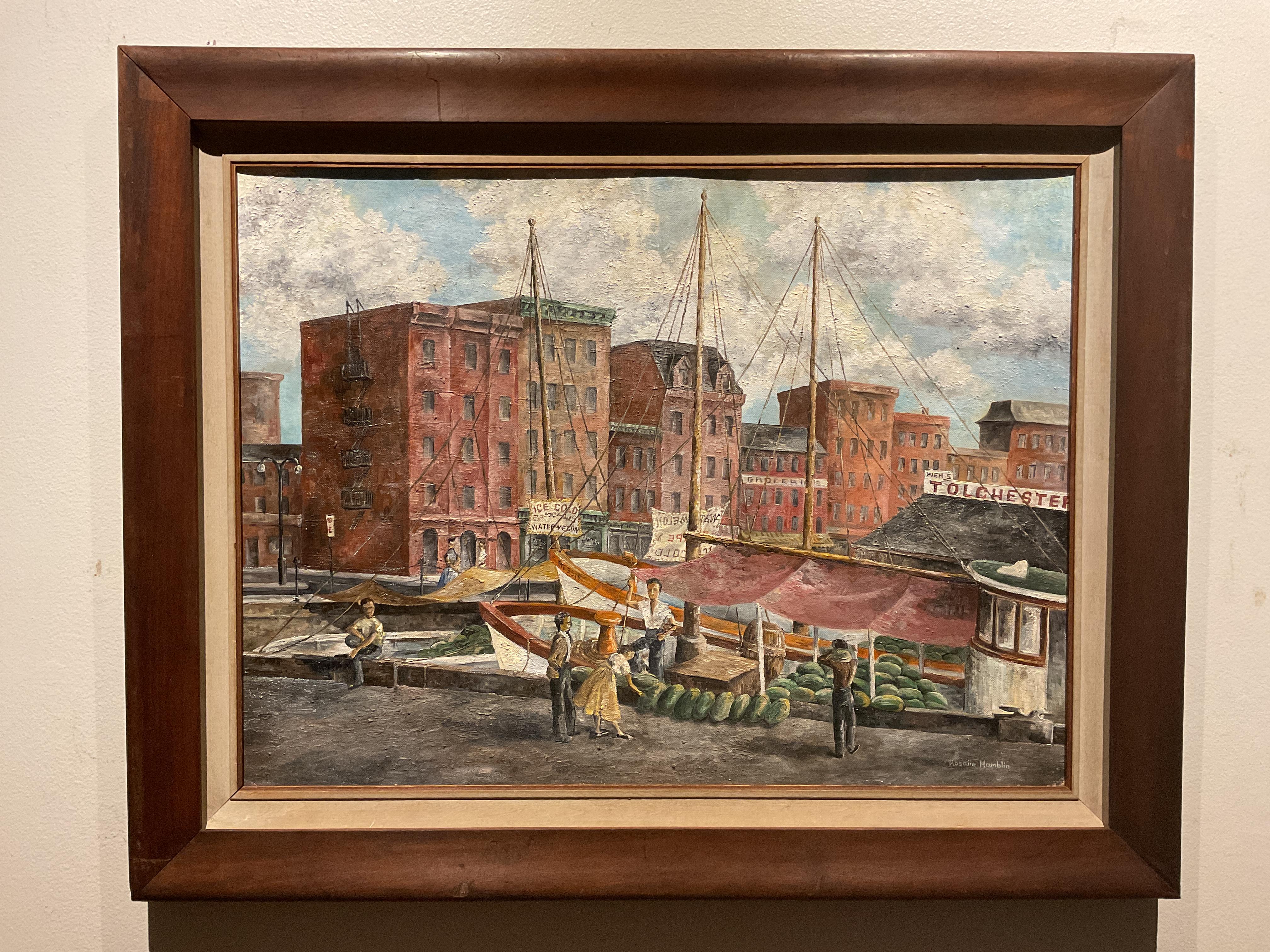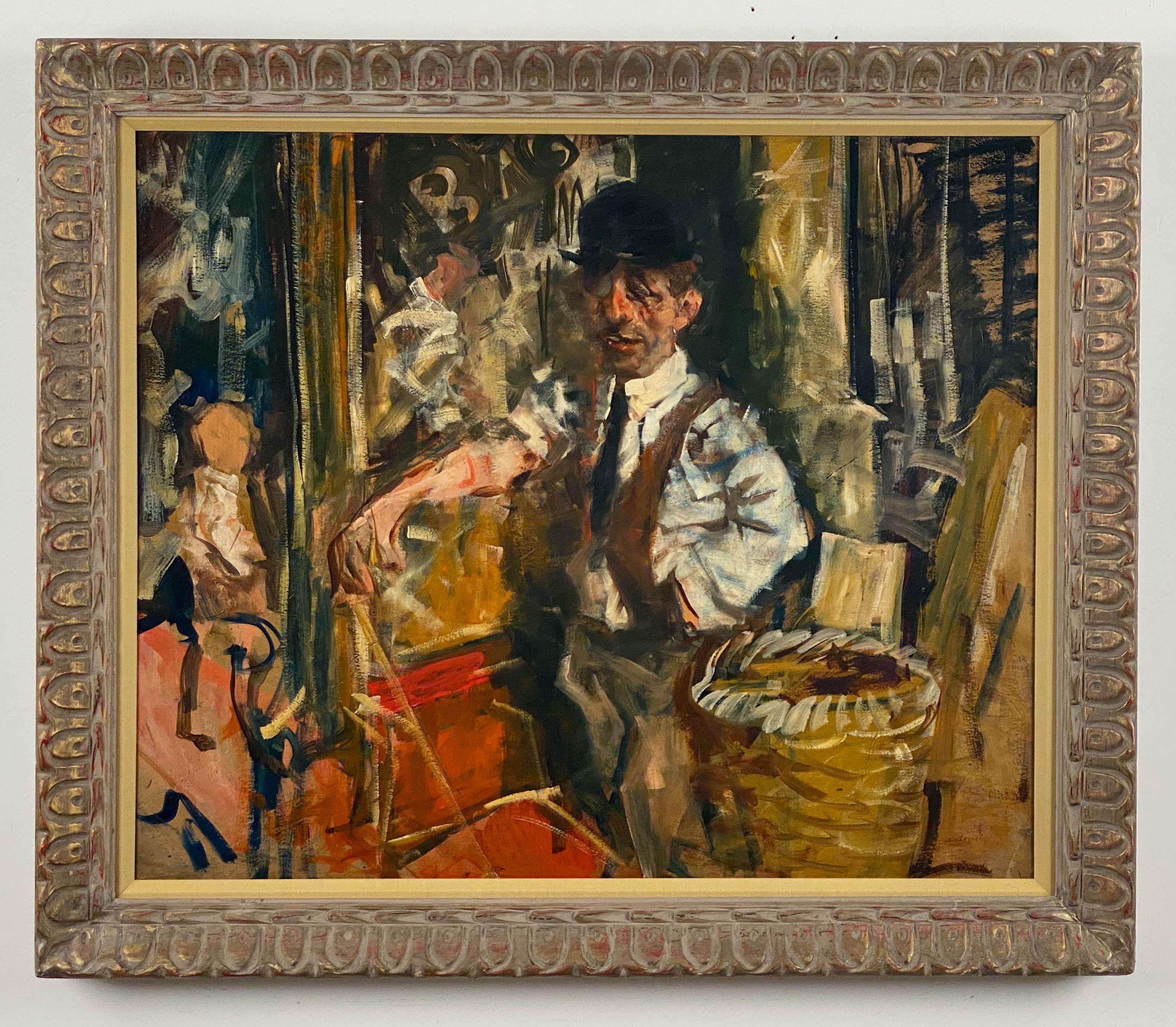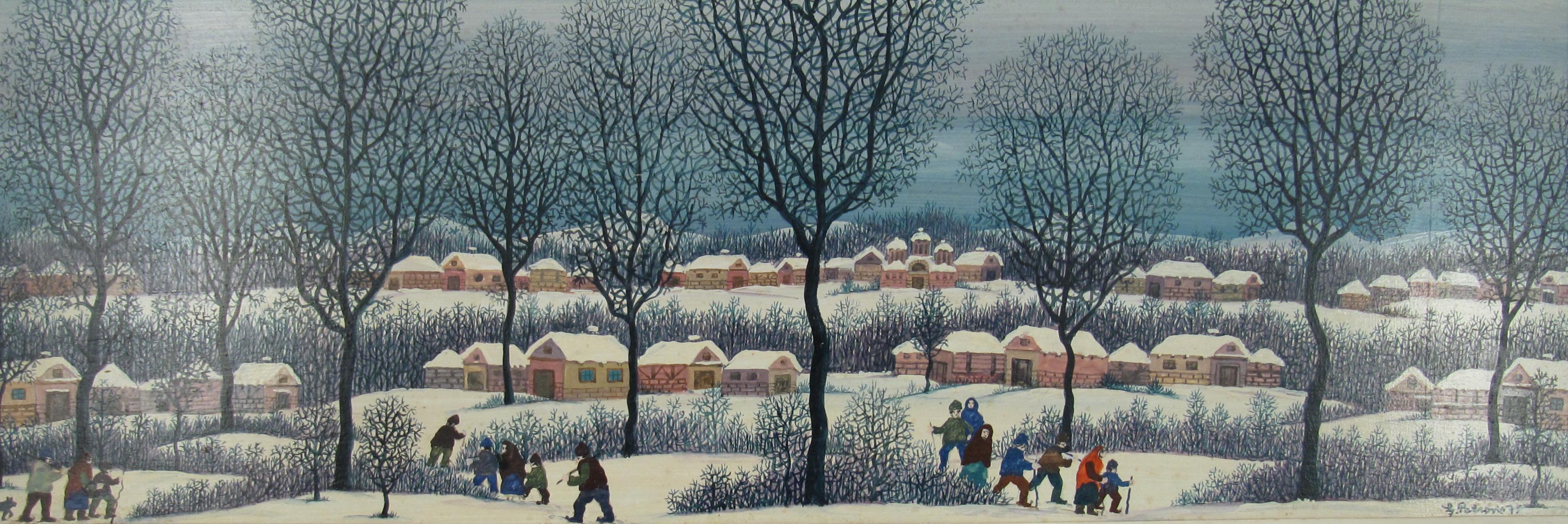Items Similar to Modernist Oil Painting the Shop Window NYC 1940s WPA era
Want more images or videos?
Request additional images or videos from the seller
1 of 8
Maurice Becker Modernist Oil Painting the Shop Window NYC 1940s WPA era
About the Item
the Shop Window New York City, 1940s
17.75X25 sight size.
Maurice Becker (1889–1975) was a radical political artist best known for his work in the 1910s and 1920s for such publications as The Masses and The Liberator.
Maurice Becker was born in Nizhni-Novgorod, Russia, the son .of ethnic Jewish parents. The family emigrated from Russia to the United States in 1892, moving to the Jewish community of the Lower East Side of New York City. His older sister was Helen Tamiris a modern dance pioneer and his brother Sam Becker was a sculptor. He studied with Ash Can (Ashcan) School artist Robert Henri in 1908. In 1913 Becker joined with Robert Henri, John Sloan, George Bellows and Stuart Davis in taking part in the famous 1913 Armory Show. Becker also began drawing cartoons. He was a great admirer of radical artists such as Art Young, Rockwell Kent and Robert Minor who were using their art in an attempt to obtain social reforms.
The young Maurice took night classes in bookkeeping and art while working days as a sign painter. He worked as an artist for the New York Tribune from 1914 to 1915, and for the Scripps newspapers from 1915 to 1918. He also contribute artwork on a freelance basis to a broad range of contemporary publications, including Harper's Weekly, Metropolitan magazine, and The Saturday Evening Post.
Maurice Becker is best remembered as an illustrator for radical magazines, most famously for the New York political and artistic magazine The Masses, to which he began to contribute in 1912.
Becker was a frequent contributor to the radical press, publishing his art in such periodicals as Revolt, The Toiler, New Solidarity, The Blast, Survey Graphic, The New York Call. and The New Masses. Becker's work, which often made use of the muted tones of graphite or charcoal, was likewise generally softer in political tone than the more hard-edged and biting work of his peers, who included Art Young, Fred Ellis, Robert Minor, Hugo Gellert, and William Gropper.
From 1921 to 1923, Becker lived in Mexico, where he worked as an artist for El Pulsa de México, an English-language magazine. After that time, he dedicated himself to painting full-time, essentially ending his career as a political artist for magazines. He did occasionally contribute art to political publications after that date, however, such as an apolitical drawing entitled "Summer," which ran in the August 1926 issue of The New Masses.
Becker remained a political radical throughout his life. He visited the Soviet Union in 1931. His name appeared on the letterhead of the Artists' Front to Win the War and he was a signatory to the call for formation of the American Artists' Congress. Maurice Becker died in 1975. He was included in the MoMA show Murals by American painters and photographers 1932, along with Ben Shahn, Stuart Davis, Bernice Abbott, George Biddle, Ernst Fiene and many other WPA and FSA artists.
Rebecca Zurier, Art for the Masses: A Radical Magazine and Its Graphics, 1911-1917. Philadelphia: Temple University Press.
- Creator:Maurice Becker (1889, American)
- Dimensions:Height: 28 in (71.12 cm)Width: 20.5 in (52.07 cm)
- Medium:
- Movement & Style:
- Period:
- Condition:cracks to the surface of the board that are stable and don't go through.
- Gallery Location:Surfside, FL
- Reference Number:1stDibs: LU38212637692
About the Seller
4.9
Platinum Seller
These expertly vetted sellers are 1stDibs' most experienced sellers and are rated highest by our customers.
Established in 1995
1stDibs seller since 2014
1,550 sales on 1stDibs
Typical response time: 1 hour
- ShippingRetrieving quote...Ships From: Surfside, FL
- Return PolicyA return for this item may be initiated within 3 days of delivery.
More From This SellerView All
- Large Modernist Oil Painting 1940s, Judaica Hasidic Shtetl Wagon Driver WPA EraBy Emanuel Glicenstein RomanoLocated in Surfside, FLGenre: Modern Subject: Landscape with figure of horse, driver and wagon Medium: Oil Surface: wood Board EMANUEL ROMANO Rome, Italy, b. 1897, d. 1984 Emanuel Glicen Romano was born in Rome, September 23, 1897. His father Henryk Glicenstein was a sculptor and was living in Rome with his wife Helena (born Hirszenberg) when Emanuel was born. His father obtained Italian citizenship and adopted the name Enrico. Emanuel was brought up in Italy, Switzerland, Germany, England and Poland. In 1926 Emanuel Glicenstein Romano and his father sailed for New York. They briefly visited Chicago. Romano's sister, Beatrice, and mother only joined them in New York years later. Romano changed his name on his arrival to America and some have erroneously speculated that this was to avoid antisemitic discrimination. In truth, as the son of a highly-regarded artist, Romano changed his name to ensure that any success or recognition he would later attain, would be the result of nothing other than his own merit as an artist, and not on account of his father's fame. In 1936 Romano was worked for the WPA Federal Art Project creating murals. ( there were many jewish artists active with in the WPA period. notably Chaim Gross, Ben Shahn, Isaac and Moses Soyer, Abraham Rattner and many others. During and immediately after World War II, Romano created a series of allegorical works depicting graphic holocaust images that were held closely by the family until after his passing. One of these works is now on permanent display in the Florida Holocaust Museum in St. Petersburg Florida. Emanuel's father died in 1942 in a car accident before they could realize their shared dream of visiting Israel. In 1944 Romano, having completed his degree at the Pennsylvania Academy of Fine Arts and the Art Institute of Chicago, began teaching at the City College of New York. Romano moved to Safed, Israel in 1953 and established an art museum in his father's memory, the Glicenstein Museum. COLLECTIONS Indianapolis Museum of Art Metropolitan Museum of Art Boston Fine Arts Museum Fogg Museum Musée Nacional de France Recently his work has been added to the Florida Holocaust Museum collection. His notable works include his holocaust themed allegorical paintings as well as portraits of Marianne Moore, his father and William Carlos Williams...Category
1930s American Modern Figurative Paintings
MaterialsOil, Board
- Judaica Meditative Rabbi at Prayer in Nature, Large Landscape Oil PaintingBy Donald Roy PurdyLocated in Surfside, FLGenre: Modern Subject: Jewish Elder , Judaic Prayer Surface: Board Country: United States signed lower left Donald Roy Purdy is an American painter whose work evolved through a rang...Category
20th Century Fauvist Figurative Paintings
MaterialsOil, Board
- Simka Simkhovitch WPA Artist Oil Painting Gouache American Modernist PowerlineBy Simka SimkhovitchLocated in Surfside, FLSimka Simkhovitch (Russian/American 1893 - 1949) This came with a small grouping from the artist's family, some were hand signed some were not. These were studies for larger paintings. Simka Simkhovitch (Симха Файбусович Симхович) (aka Simka Faibusovich Simkhovich) (Novozybkov, Russia May 21, 1885 O.S./June 2, 1885 N.S.—Greenwich, Connecticut February 25, 1949) was a Ukrainian-Russian Jewish artist and immigrant to the United States. He painted theater scenery in his early career and then had several showings in galleries in New York City. Winning Works Progress Administration (WPA) commissions in the 1930s, he completed murals for the post offices in Jackson, Mississippi and Beaufort, North Carolina. His works are in the permanent collections of the Dallas Museum of Art, the National Museum of American Art and the Whitney Museum of American Art. Born outside Kyiv (Petrograd Ukraine) into a Jewish family who owned a small department store. During a severe case of measles when he was seven, Simcha Simchovitch sketched the views outside his window and decided to become an artist, over his father's objections. Beginning in 1905, he studied at the Grekov Odessa Art School and upon completion of his studies in 1911 received a recommendation to be admitted to the Imperial Academy of Arts. Though he enrolled to begin classes in architecture, painting, and sculpture at the Imperial Academy, he was dropped from the school roster in December because of the quota on the number of Jewish students and drafted into the army. Simchovitch served as a private in the 175th Infantry Regiment Baturyn [ru] until his demobilization in 1912. Re-enrolling in the Imperial Academy, he audited classes. Simka Simkhovitch exhibited paintings and sculptures in 1918 as part of an exhibition of Jewish artists and in 1919 placed 1st in the competition "The Great Russian Revolution" with a painting called "Russian Revolution" which was hung in the State Museum of Revolution. In 1922, Simkha Simkhovitch exhibited at the International Book Fair in Florence (Italian: Fiera Internazionale del Libro di Firenze). In 1924, Simkhovitch came to the United States to make illustrations for Soviet textbooks and decided to immigrate instead. Initially he supported himself by doing commercial art and a few portrait commissions. In 1927, he was hired to paint a screen for a scene in the play "The Command to Love" by Fritz Gottwald and Rudolph Lothar which was playing at the Longacre Theatre on Broadway. Art dealers began clamoring for the screen and Simkhovitch began a career as a screen painter for the theater. Catching the attention of the screenwriter, Ernest Pascal, he worked as an illustrator for Pascal, who then introduced him to gallery owner, Marie Sterner. Simkhovitch's works appeared at the Marie Sterner Gallery beginning with a 1927 exhibit and were repeated the following year. Simkhovitch had an exhibit in 1929 at Sterner's on circus paintings. In 1931, he held a showing of works at the Helen Hackett Gallery, in New York City and later that same year he was one of the featured artists of a special exhibit in San Francisco at the California Palace of the Legion of Honor in Lincoln Park. The exhibit was coordinated by Marie Sterner and included four watercolors, including one titled "Nudes". He is of the generation of Russian Soviet artists such as Isaac Pailes, Serge Charchoune, Marc Chagall, Chana Orloff, Isaac Ilyich Levitan, and Ossip Zadkine. In 1936, Simkhovitch was selected to complete the mural for the WPA Post office project in Jackson, Mississippi. The mural was hung in the post office and courthouse in 1938 depicted a plantation theme. Painted on the wall behind the judge’s bench, “Pursuits of Life in Mississippi”, a depiction of black workers engaged in manual labor amid scenes of white professionals and socialites, was eventually covered over in later years during renovations due to its stereotypical African American imagery. Simka painted what he thought was typical of Jackson. His impression of pre-civil rights Mississippi was evidently Greek Revival column houses, weeping willow trees, working class families, and the oppression of African Americans. He painted African American men picking cotton, while a white man took account of the harvest and a white judge advised a white family, calling it Pursuits of Life in Mississippi. Though clearly endorsed by the government and initially generally well-received, the mural soon raised concerns with locals as the climate toward racial segregation began to change. The main concern was whether depictions that show African Americans in subjugated societal roles should be featured in a courtroom. The following year, his painting "Holiday" won praise at an exhibition in Lincoln, Nebraska. In 1940, Simkhovitch's second WPA post office project was completed when four murals, "The Cape Lookout Lighthouse and the Orville W. Mail Boat", "The Wreck of the Crissie Wright", "Sand Ponies" and "Canada Geese" were installed in Beaufort, North Carolina. The works were commissioned in 1938 and did not generate the controversy that the Jackson mural had. The main mural is "The Wreck of the Crissie Wright" and depicts a shipwreck which had occurred in Beaufort in 1866. "The Cape Lookout Lighthouse and the Orville W. Mail Boat" depicted the lighthouse built in 1859 and the mail boat that was running mail during the time which Simkhovitch was there. The boat ran mail for the area until 1957. "Sand Ponies" shows the wild horses common to the North Carolina barrier islands and "Canada Geese" showed the importance of hunting and fishing in the area. All four murals were restored in the 1990s by Elisabeth Speight, daughter of two other WPA muralists, Francis Speight...Category
1930s American Modern Landscape Paintings
MaterialsGouache, Oil, Board
- Simka Simkhovitch WPA Artist Oil Painting American Modernist Landscape Pond TreeBy Simka SimkhovitchLocated in Surfside, FLSimka Simkhovitch (Russian/American 1893 - 1949) This came with a small grouping from the artist's family, some were hand signed some were not. Thes...Category
1930s American Modern Landscape Paintings
MaterialsOil, Board
- Simka Simkhovitch WPA Artist Oil Painting American Modernist Landscape w TowerBy Simka SimkhovitchLocated in Surfside, FLSimka Simkhovitch (Russian/American 1893 - 1949) This came with a small grouping from the artist's family, some were hand signed some were not. Thes...Category
1930s American Modern Landscape Paintings
MaterialsOil, Board
- French Riviera Harbor Scene Oil Painting Ecole D'Paris, WPA, Bezalel ArtistBy Jacques ZuckerLocated in Surfside, FLGenre: Post Impressionist Subject: Landscape Medium: Oil Surface: board Country: France Dimensions: 13" x 16" Jacques Zucker was born in 1900 in Radom, Poland. He was a notably famous Jewish American artist mostly known for his expressionist figure paintings. In his young years he traveled to Palestine to study fine arts at the Bezalel Art School in Jerusalem. In 1917 he joined the British Royal Fuesiliers under the leadership of General Allenby to liberate Palestine from the Turks. After the first World War he settled in Paris, where he continued his studies at Académie Julian and Academie Colarossi. He then emigrated to the United States in 1922 and continued his art studies at the National Academy of Design. He supported himself by designing jewelry. In 1925 he returned to Paris and studied at the Academie de la Grande Chaumier et Colarossi. During the Depression he worked for the WPA. From 1928 he took part in the Paris Salons: Autumn and the Tuileries. His works are expressionistic variations in the type of the Ecole de Paris. As a protégé of both Chaim Soutine and Renoir, hints of their style can be observed in much of his own work. Zucker’s style, that may have been influenced from the art of artists such as Marc Chagall, took pride in being an “internationalist”, standing the art of painting in its highest expression is universal no matter where the canvas was created. People who respond to quality in art will understand the beauty and meaning, in their own land or in a foreign land, this was his main idea behind his artworks that was exhibited in numerous solo show in leading galleries and museums in New York, Paris, Tel Aviv, and other art centers. Claude Roger-Marx of Figaro Litteraire, dean of French art critics, write a comprehensive study of Zucker’s illustrated with 135 color and black and white plates. He traveled widely, including Italy, Spain, Portugal, Mexico and Israel. From then on Zucker lived alternately in New York and Paris, maintaining homes in both places, and spent considerable time painting in Mexico, Portugal, Greece, and Israel. Zucker's post-impressionist works including town and landscapes, still-lives, and portraits, are part of an array of permanent installments in numerous museums and private collections in Tel Aviv, including the Joseph Hirschorn collection in Washington, D. C., the Museum of Modern Art in Paris, and the Bezalel Art Museum in Jerusalem. In 1947 he settled in Arcueil near Paris. Zucker died in 1981 in New York. The School of Paris, Ecole de Paris, was not a single art movement or institution, but refers to the importance of Paris as a center of Western art in the early decades of the 20th century. Between 1900 and 1940 the city drew artists from all over the world and became a centre for artistic activity. School of Paris was used to describe this loose community, particularly of non-French artists, centered in the cafes, salons and shared workspaces and galleries of Montparnasse. Before World War I, a group of expatriates in Paris created art in the styles of Post-Impressionism, Cubism and Fauvism. The group included artists like Pablo Picasso, Marc Chagall, Amedeo Modigliani and Piet Mondrian. Associated French artists included Pierre Bonnard, Henri Matisse, Jean Metzinger and Albert Gleizes. The term "School of Paris" was used in 1925 by André Warnod to refer to the many foreign-born artists who had migrated to Paris. The term soon gained currency, often as a derogatory label by critics who saw the foreign artists—many of whom were Jewish—as a threat to the purity of French art. Art critic Louis Vauxcelles, noted for coining the terms "Fauvism" and "Cubism", Waldemar George, himself a French Jew, in 1931 lamented that the School of Paris name "allows any artist to pretend he is French. it refers to French tradition but instead annihilates it. The artists working in Paris between World War I and World War II experimented with various styles including Cubism, Orphism, Surrealism and Dada. Foreign and French artists working in Paris included Jean Arp, Joan Miro, Constantin Brancusi, Raoul Dufy, Tsuguharu Foujita, artists from Belarus like Michel Kikoine, Pinchus Kremegne, and Jacques Lipchitz, the Polish artist Marek Szwarc and others such as Russian-born prince Alexis Arapoff. A significant subset, the Jewish artists, came to be known as the Jewish School of Paris or the School of Montparnasse. The core members were almost all Jews, and the resentment expressed toward them by French critics in the 1930s was unquestionably fueled by anti-Semitism. Jewish members of the group included Emmanuel Mané-Katz, Chaim Soutine, Adolphe Féder, Chagall, Moïse Kisling, Maxa Nordau and Shimshon Holzman...Category
Mid-20th Century Post-Impressionist Landscape Paintings
MaterialsBoard, Oil
You May Also Like
- "After the Storm"By John R. GrabachLocated in Lambertville, NJSigned LL John Grabach was a highly regarded New Jersey artist, teacher and author of a classic text, How to Draw the Human Figure. He was born in Massachusetts, and with his widow...Category
20th Century Ashcan School Figurative Paintings
MaterialsOil, Panel
- New York scene done by John Grabach Artist "Trinity Church - Wall Street"Located in Rockport, MAGreat Wall Street piece by John R. Grabach (March 2, 1886 – March 17, 1981) with expressive colors and figures. Grabach was a renowned American painter, best known for his evocative...Category
1920s Ashcan School Figurative Paintings
MaterialsOil
- Rare Baltimore Harbor Oil Painting, Pratt Street Dock, ca 1950 - Rosalie HamblinLocated in Baltimore, MDThis lively oil painting depicts Baltimore’s busy waterfront, specifically the former piers that lined Pratt Street in the Inner Harbor. Painted by local artist Rosalie Mills ( née Hamblin), the scene depicts the watermelon boats that berthed near Pier 5. The painting dates to the 1950’s. The historic buildings that once lined Pratt Street, before urban renewal clearance of the 1960’s, provide the background for the scene. Hamblin’s attention to detail is quite good and calls to mind other Baltimore painters...Category
1950s Ashcan School Figurative Paintings
MaterialsOil
- Outside a DeliBy Jack LevineLocated in Sheffield, MAJack Levine American, 1915-2010 The Deli Oil on board 28 ¼ by 34 in. W/frame 36 ¼ by 42 in. Signed Lower Right Born and raised in the south end of Boston, Jack Levine created soc...Category
1940s Ashcan School Figurative Paintings
MaterialsOil
- Ljuba Petrović ( Serbian, 1928 ) Busy Winter Landscape Oil Painting Serbia 1973Located in Meinisberg, CHLjuba Petrović (Serbian, 1928) Busy Winter Landscape • Oil on artist board / thick card • Alluminium frame ca. 35 x 77 cm • Visible image ca. 20.5 x 62.5 cm • Signed and dated lower right (19)73 • Good, untouched original condition Ljuba Petrović is a Serbian painter born in 1928 in Nis, ex Yugoslavia / now Serbia. Originally an agricultural worker, he later worked as a painter decorator and served as a town hall official in his native Nis. He went on to create frescos, wall paintings and small paintings, which after joining local exhibitions, he exhibited in 1973 in Geneva, Switzerland and in the eighties successfully in Paris, at the Salon International d'Art Naïf. Petrović is a typical representative of the Yugoslave naïve school of painting...Category
1970s Other Art Style Figurative Paintings
MaterialsBoard, Oil
- Rudolf Johann Weiss ( 1846 – 1933 ) Twannbach Cave Oil Painting Switzerland 1926By Rudolf Johann WeissLocated in Meinisberg, CHRudolf Johann Weiss (Swiss, * 3.9.1846 Basel, † 17.4.1933 Biel) Die Twannbachgrotte/Twannbachschlucht bei Twann, Biel, Schweiz (= The Twannbach Cave/Twannbach Canyon by Douanne, Bie...Category
1920s Post-Impressionist Landscape Paintings
MaterialsOil, Board
